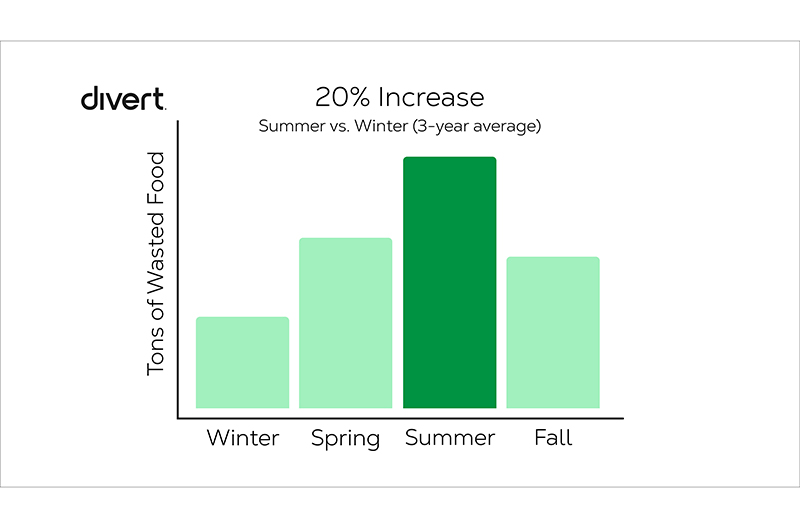West Concord, Massachusetts-based Divert Inc., an impact technology company, has shared new data highlighting that wasted food from grocery stores increases by an average of about 20 percent during the summer months compared to the winter months.
“Summer marks peak growing season across the U.S. While this is a time to celebrate an abundance of fresh produce and gather with our family and friends, our data indicates that the summer is also a period when a significant amount of that produce goes to waste,” Ryan Begin, CEO and co-founder, said in a statement.
“Divert is committed to reducing wasted food by bringing together the industry, driving awareness and deploying solutions to prevent unnecessary waste – whether it’s in consumers’ kitchens or on the grocery store shelf.”
Divert analyzed wasted food processed at its facilities across the U.S. from 2020-22 during the months of July, August and September, compared to January, February and March. In its analysis, the company has identified a number of key factors – and what both consumers and retailers can do to address them:
- Peak produce season
- An increased abundance of produce during the summer months translates to a greater volume coming into grocery stores. In addition to a greater selection, more fresh food can go to waste if it is not moved and sold quickly enough.
- Technologies like artificial intelligence and Internet of Things solutions can be utilized to identify trends or issues in stores, and uncover insights that can inform food retailers’ future processes to prevent unnecessary waste.
- Heat and human error
- When produce is exposed to greater temperature fluctuations, the percentage of wasted food increases for retailers. In the heat of the summer, produce left on a retailer’s loading dock for too long can cause it to lose freshness quickly.
- Increased awareness and appropriate training of retail employees led by data-driven insights could help to address this.
- Consumer Demands for Perfection
- With large amounts of produce and fresh foods during the warmer months, consumers are shopping for more fruits and vegetables than they need, which then go to waste. There is also sustained demand from consumers for the best looking, unblemished produce.
- The solution here starts with retailers and consumers changing their perceptions to see the value in all food. Stores can improve their food donations program or mark down soon-to-expire products, encouraging conscious consumption. Consumers can also rethink their approach to purchasing food and recognize that appearance does not always correlate to nutrition, quality and taste.
While summer shows a consistent increase in the amount of wasted food, this is a year-round crisis; 63 million pounds of food is thrown away annually in the U.S. alone, and wasted food contributes up to 10 percent of greenhouse gas emissions globally.
Divert has made progress in addressing this crisis through its technologies, logistics and sustainable infrastructure, processing more than 2.3 billion pounds of wasted food working with nearly 5,400 retail stores across the U.S.

